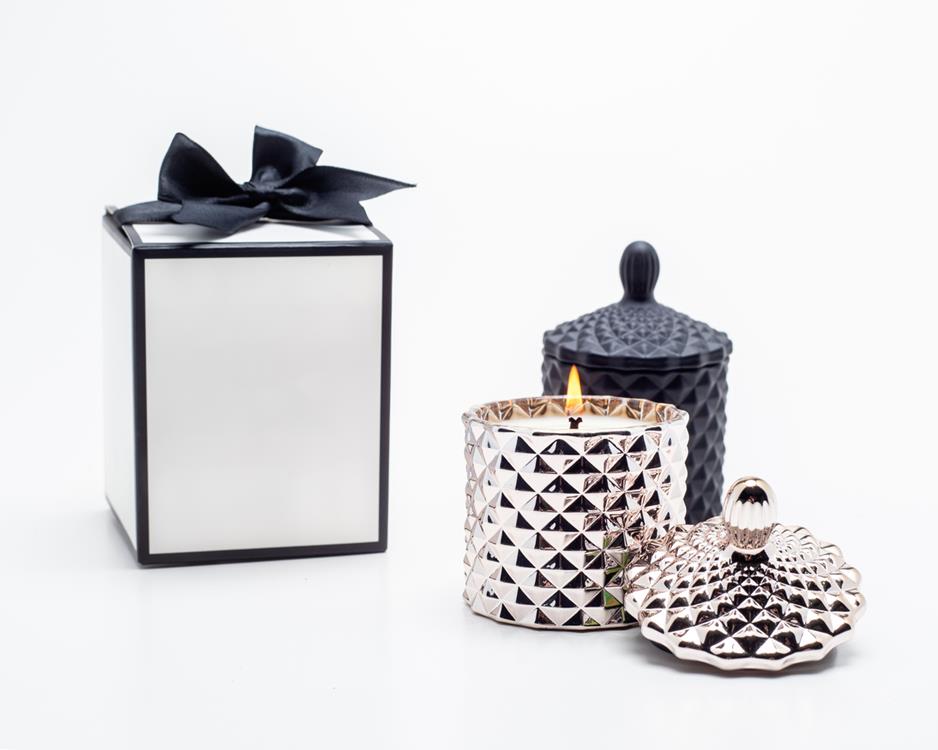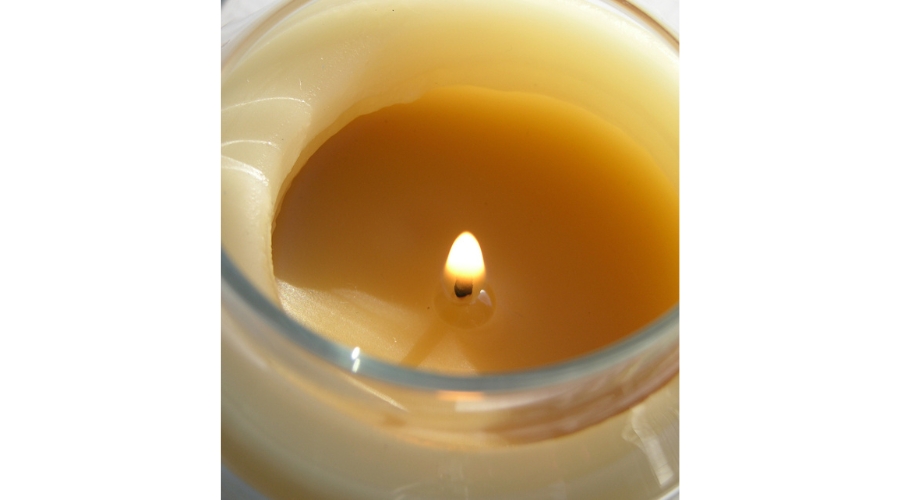Soy, Beeswax, or Paraffin? The Scientific Differences Between Candle Waxes
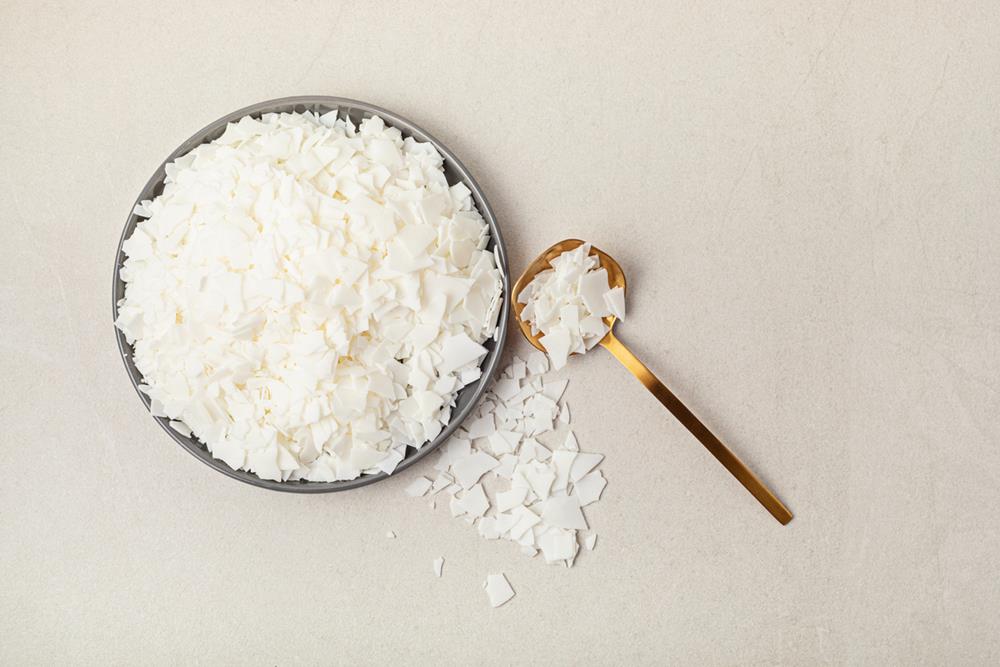
Not all candles are created equal—and much of that comes down to the type of wax they’re made from. Whether you’re drawn to the natural appeal of beeswax, the clean-burning qualities of soy, or the affordability of paraffin, each wax has its own unique chemistry and performance.
These differences don’t just affect burn time and scent throw—they also impact things like soot production, environmental footprint, and overall candle quality. In this article, we’ll break down the scientific distinctions between soy, beeswax, and paraffin waxes to help you better understand what’s in your candle and why it matters.
| Feature | Soy Wax | Beeswax | Paraffin Wax |
|---|---|---|---|
| Source | Hydrogenated soybean oil (plant-based) | Produced naturally by honey bees | Byproduct of petroleum refining |
| Burn Time | Slow and cool burn, up to 50% longer than paraffin | Slow, steady burn with air-purifying benefits | Burns faster than soy and beeswax |
| Soot Production | Low | Very low | Higher soot output |
| Scent Throw | Mild to moderate | Natural honey scent, low throw | Strong fragrance release |
| Aesthetic Appearance | May develop frosting or shrinkage; matte finish | Golden color, rustic charm | Shiny, smooth, polished appearance |
| Environmental Impact | Biodegradable and renewable; concerns with farming practices | Eco-friendly; supports sustainable beekeeping | Non-renewable; contributes to indoor pollution |
| Cost | Moderate; more affordable than beeswax | Expensive; premium pricing | Most affordable and widely available |
| Best Uses | Container candles, eco-conscious buyers | Pillar candles, air-purifying candles | Commercial candles, strong-scented products |
The Basics of Candle Wax Types
When it comes to candle making, the type of wax used plays a big role in how the candle looks, burns, and even smells. The three most common waxes—soy, beeswax, and paraffin—each have unique properties based on their source and chemical makeup.
Soy wax is made from hydrogenated soybean oil, making it a biodegradable and eco-friendly choice. It burns cleaner, cooler, and longer than paraffin, which means fewer toxins in the air and a slower melt.
Paraffin wax, a byproduct of petroleum refining, is popular for its affordability and excellent scent throw. It's often used in mass-produced candles, but it tends to release more soot when burned, which may affect indoor air quality.
Beeswax, produced naturally by honey bees, has its own unique appeal. It burns cleanly, emits a natural honey-like scent, and even releases negative ions, which can help purify the air. What’s more, beeswax supports sustainable beekeeping, an essential practice for pollination and global food production.
Each type of wax affects a candle’s burn time, fragrance performance, appearance, and environmental impact. Understanding these differences helps you choose the best candle for your needs—whether you’re making your own or buying one for your home.
Exploring Soy Wax Characteristics
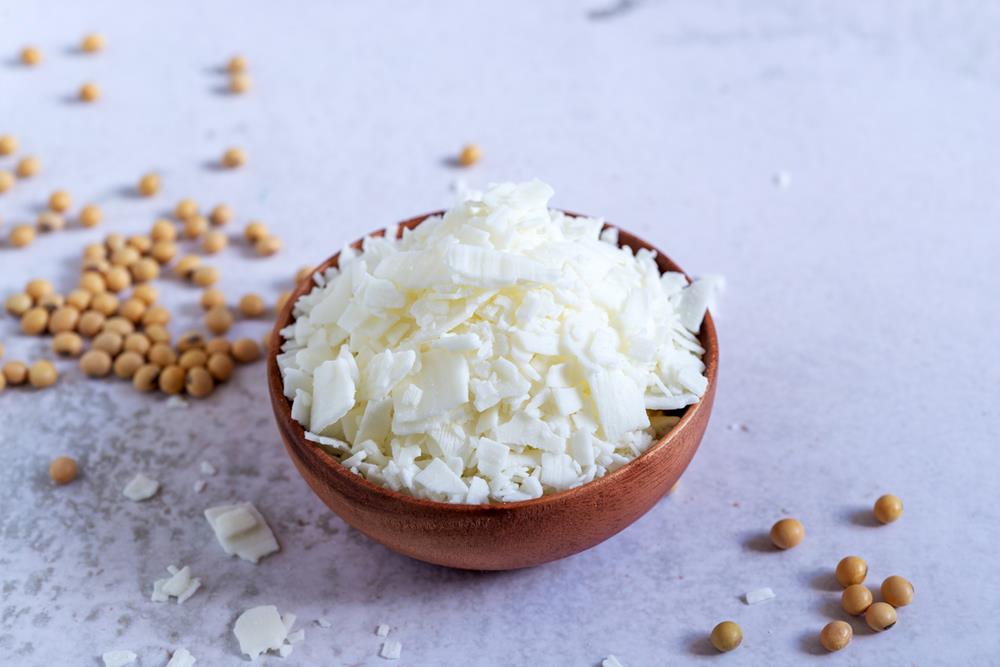
Soy wax is a popular choice for candle lovers who care about sustainability. Made from hydrogenated soybean oil, it's a natural, renewable, and biodegradable alternative to synthetic waxes.
One of soy wax’s biggest advantages is its slow, steady burn—it can last up to 50% longer than paraffin wax when properly cared for. It’s also more affordable than other natural waxes like beeswax, making it a great middle-ground option for both casual users and serious candle makers.
That said, soy wax does have a few quirks. It can be sensitive to temperature changes, sometimes causing cosmetic issues like frosting (a white, cloudy surface) or shrinkage as it cools. These don’t affect performance, but they can change the look of the candle.
In terms of air quality, soy wax burns cleaner than paraffin, producing less soot. However, its scent throw (how well it fills a room with fragrance) is typically milder, which means scents may be more subtle compared to paraffin-based candles.
Overall, soy wax is a great choice if you want a candle that’s clean-burning, long-lasting, and eco-conscious—just with a few aesthetic trade-off.
Unique Qualities of Beeswax

Beeswax has long been a favorite among candle makers—and for good reason. As the oldest known candle material, it’s naturally produced by honey bees and comes with several standout benefits that make it both functional and luxurious.
One of its most loved qualities is its natural honey-like scent. Unlike other waxes, beeswax doesn't need added fragrance—it smells amazing all on its own. It also burns slower and longer than many other wax types, giving you a longer-lasting candle with less waste.
Another unique benefit is its ability to release negative ions when burned, which can help neutralize pollutants, dust, and allergens in the air—potentially improving indoor air quality. Combined with its minimal soot production, this makes beeswax a smart choice for those with respiratory sensitivities.
Visually, beeswax stands out with its rich golden color and firm texture, making it ideal for pillar candles, molds, and durable containers. It holds its shape well and offers a clean, drip-free burn when properly made.
Lastly, choosing eco-friendly candles like beeswax supports natural production methods, reduces reliance on synthetic materials, and promotes sustainability in candle making.
If you're looking for a candle that’s clean, long-lasting, and naturally beautiful, beeswax is a hard wax to beat.
Insights Into Paraffin Wax

Paraffin wax may be a byproduct of petroleum refining, but it remains one of the most widely used waxes in the candle-making industry—and for good reason.
Paraffin is especially valued for its strong scent throw. It holds and releases fragrance oils exceptionally well, making it a go-to for those who want a candle that fills a room with scent. It also creates a smooth, glossy finish that resists cosmetic issues like frosting, giving candles a polished, professional appearance.
However, there are a few trade-offs. Paraffin wax typically burns faster than soy or beeswax, meaning shorter burn times. It can also produce more soot, which may affect indoor air quality over time—especially if the wick isn’t properly trimmed or the candle burns in a drafty space.
Still, paraffin’s versatility is a major advantage. Available in various melt points, it works well for everything from container candles to pillars and votives. Its consistency and cost-effectiveness make it a staple for both commercial and hobbyist candle makers.
If you prioritize bold fragrance and smooth appearance, paraffin candles might be the right fit—just be mindful of proper burning habits to reduce smoke and soot.
Environmental Considerations of Each Wax

When choosing a candle wax, it's crucial to contemplate the environmental impact of each option.
Soy wax, made from soybeans, is renewable and biodegradable, but its sustainability is sometimes questioned due to deforestation and pesticide use.
Beeswax, produced by honey bees, stands out as an eco-friendly choice. It not only comes from a natural source but also improves indoor air quality by releasing negative ions. However, beeswax candles often cost more.
On the other hand, paraffin wax, a petroleum byproduct, lacks eco-friendly credentials. It burns faster than soy and beeswax, leading to shorter candle life and potentially more waste. Moreover, paraffin can contribute to indoor air pollution with soot.
Considering these factors helps you make a sustainable choice.
Burning Properties and Longevity
Choosing the right candle wax involves understanding how each type burns and its longevity.
Soy wax offers a slower, cooler burn, extending the candle's life by up to 50% with proper care. Beeswax also provides a lengthy burn time, naturally cleaning the air as it emits negative ions. In contrast, paraffin wax burns faster, which means a shorter lifespan for your candle.
Here’s a quick breakdown:
- Soy wax: Long burn time and gradual fragrance release.
- Beeswax: Extended burn time with air-purifying benefits.
- Paraffin wax: Quick burn with strong fragrance oils.
- Soot production: Less with soy and beeswax, more with paraffin.
Choose based on your preference for burn time and how you’d like to enjoy your fragrance oils.
Fragrance Release and Scent Throw
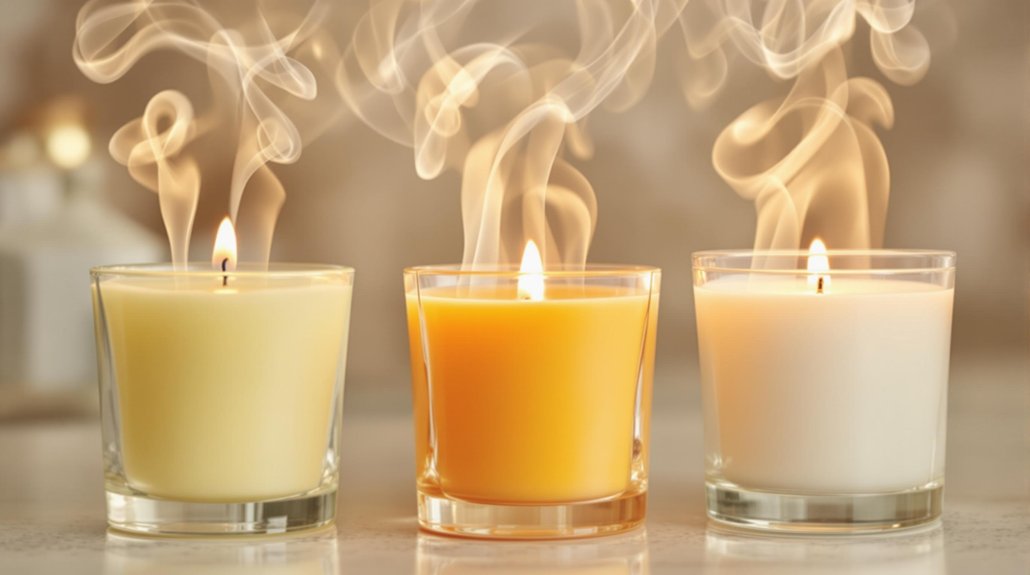
As you investigate candle wax options, you’ll find that the type of wax also affects how fragrances are released and experienced.
Paraffin wax excels in fragrance retention and scent throw, making it the go-to choice for those who love strong, aromatic candles. It can hold a large amount of fragrance, especially in its softer form, enhancing the complete scent experience.
Soy wax offers a good scent throw but doesn’t retain fragrance as effectively as paraffin, resulting in a more subtle aroma.
Beeswax, on the other hand, naturally emits a gentle honey-like scent, offering a unique experience but with a weaker scent throw compared to synthetic options.
Each wax type delivers a different olfactory experience, influencing your choice based on fragrance needs.
Aesthetic Outcomes and Appearance
The visual appeal of a candle is greatly influenced by the type of wax used.
Soy wax candles often develop a frosty appearance due to temperature sensitivity, which can affect their aesthetic appeal.
In contrast, beeswax candles offer a naturally golden color and sleek finish, providing a rustic charm that many find visually appealing.
Paraffin waxes deliver a shiny, smooth surface, avoiding frost, and offer a modern, uniform aesthetic.
Color options vary:
- Soy wax candles: Eco-friendly appeal, but may frost.
- Beeswax candles: Limited color options, naturally golden hue.
- Paraffin waxes: Easily dyed, modern look.
- Beeswax: Ideal for pillars and containers, harder and solid.
Each wax type presents unique aesthetic outcomes, from eco-friendly to sleek modernity.
Cost and Accessibility
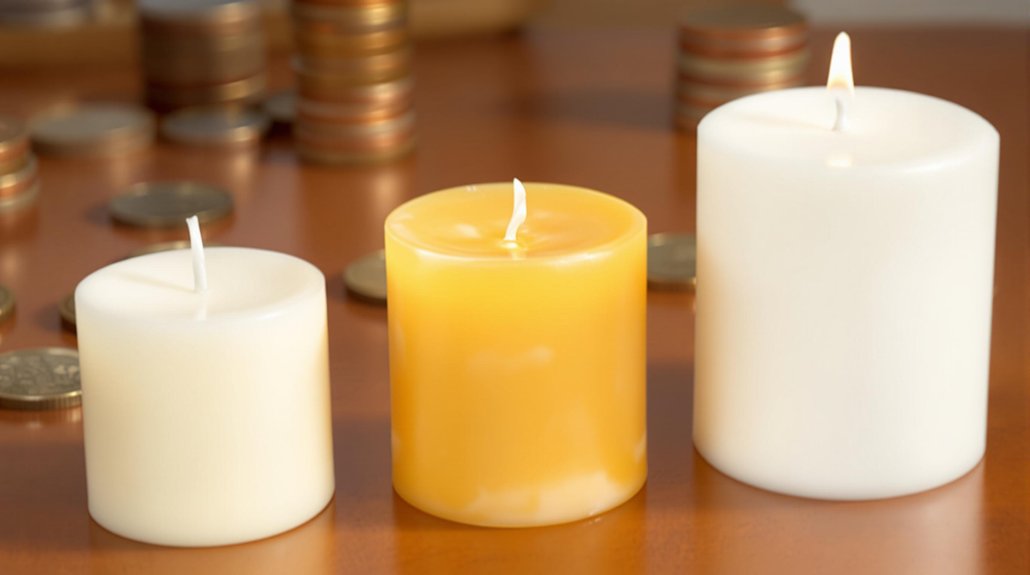
When considering candle-making materials, cost and accessibility can considerably influence your choice. Soy wax often stands out as a cost-effective option for budget-conscious creators. It's more affordable than natural alternatives like beeswax, which carries a higher price tag, affecting its accessibility.
For those seeking the most economical option, paraffin wax is the clear winner. Its low production cost and widespread availability make it a staple in commercial use.
However, while soy wax is derived from renewable resources, the production may involve deforestation and pesticide issues, potentially impacting both cost and accessibility.
Blended waxes offer a balanced solution, combining different wax types to deliver performance without breaking the bank, making them accessible to a wider audience. Choose wisely based on your priorities.
Choosing the Right Wax for Your Needs
Choosing the right wax for your candles depends on several factors, including your values and needs.
If you're eco-conscious, soy wax is a renewable, biodegradable option that aligns with eco-friendly values. For a natural scent, beeswax gives off a honey-like aroma and improves indoor air quality. If you're budget-focused, paraffin wax is the most cost-effective and retains fragrance well, though it’s less eco-friendly.
Consider the burn time:
- Soy: Burns up to 50% longer than paraffin.
- Beeswax: Offers a slow, enduring burn.
- Paraffin: Shiny finish but shorter burn time.
- Soy: May develop a frosted appearance.
Your choice hinges on what matters most—whether it's sustainability, scent, budget, or appearance. Each wax offers unique qualities to complement your candle-making needs.

